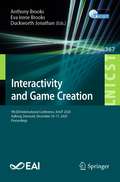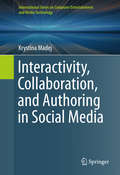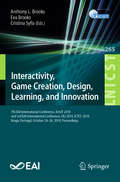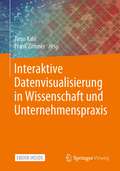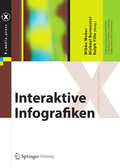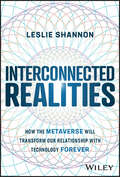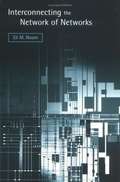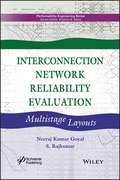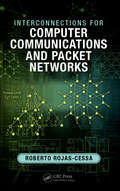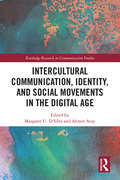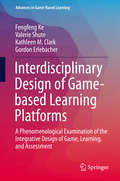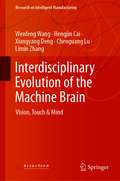- Table View
- List View
Interactivity and Game Creation: 9th EAI International Conference, ArtsIT 2020, Aalborg, Denmark, December 10–11, 2020, Proceedings (Lecture Notes of the Institute for Computer Sciences, Social Informatics and Telecommunications Engineering #367)
by Anthony Brooks Eva Irene Brooks Duckworth JonathanThis book constitutes the refereed post-conference proceedings of the 9th International Conference on Interactivity and Game Creation, ArtsIT 2020, held in Aalborg, Denmark, in December 2020. Due to COVID-19 pandemic the conference was held virtually. The 28 revised full papers presented were carefully selected from 60 submissions. The papers represent a forum for the dissemination of cutting-edge research results in the area of arts, design and technology, including open related topics like interactivity and game creation. They are grouped in terms of content on art, installation and performance; games; design; intelligence and creativity in healthcare; wellbeing and aging.
Interactivity, Collaboration, and Authoring in Social Media
by Krystina MadejThis book includes a short history of interactive narrative and an account of a small group collaboratively authored social media narrative: Romeo and Juliet on Facebook: After Love Comes Destruction. At the forefront of narrative innovation are social media channels - speculative spaces for creating and experiencing stories that are interactive and collaborative. Media, however, is only the access point to the expressiveness of narrative content. Wikis, messaging, mash-ups, and social media (Facebook, Twitter, YouTube and others) are on a trajectory of participatory story creation that goes back many centuries. These forms offer authors ways to create narrative meaning that reflects our current media culture, as the harlequinade reflected the culture of the 18th century, and as the volvelle reflected that of the 13th century. Interactivity, Collaboration, and Authoring in Social Media first prospects the last millennium for antecedents of today's authoring practices. It does so with a view to considering how today's digital manifestations are a continuation, perhaps a reiteration, perhaps a novel pioneering, of humans' abiding interest in interactive narrative. The book then takes the reader inside the process of creating a collaborative, interactive narrative in today's social media through an authoring experience undertaken by a group of graduate students. The engaging mix of blogs, emails, personal diaries , and fabricated documents used to create the narrative demonstrates that a social media environment can facilitate a meaningful and productive collaborative authorial experience and result in an abundance of networked, personally expressive, and visually and textually referential content. The resulting narrative, After Love Comes Destruction, based in Shakespeare's Romeo and Juliet, shows how a generative narrative space evolved around the students' use of social media in ways they had not previously considered both for authoring and for delivery of their final narrative artifact.
Interactivity, Game Creation, Design, Learning, and Innovation: 5th International Conference, Artsit 2016, And First International Conference, Dli 2016, Esbjerg, Denmark, May 2-3, 2016. Proceedings (Lecture Notes of the Institute for Computer Sciences, Social Informatics and Telecommunications Engineering #196)
by Anthony L. Brooks Eva Brooks Nikolas VidakisThis book constitutes the proceedings of two conferences: The 6th International Conference on ArtsIT, Interactivity and Game Creation (ArtsIT 2017) and the Second International Conference on Design, Learning and Innovation (DLI 2017). The event was hosted in Heraklion, Crete, Greece, in October 2017 and attracted 65 submissions from which 50 full papers were selected for publication in this book. The papers represent a forum for the dissemination of cutting-edge research results in the area of arts, design and technology, including open related topics like interactivity and game creation.
Interactivity, Game Creation, Design, Learning, and Innovation: 7th EAI International Conference, ArtsIT 2018, and 3rd EAI International Conference, DLI 2018, ICTCC 2018, Braga, Portugal, October 24–26, 2018, Proceedings (Lecture Notes of the Institute for Computer Sciences, Social Informatics and Telecommunications Engineering #265)
by Anthony L. Brooks Eva Brooks Cristina SyllaThis book constitutes the refereed post-conference proceedings of two conferences: The 7th EAI International Conference on ArtsIT, Interactivity and Game Creation (ArtsIT 2018), and the 3rd EAI International Conference on Design, Learning, and Innovation (DLI 2018). Both conferences were hosed in Braga, Portugal, and took place October 24-26, 2018. The 51 revised full papers presented were carefully selected from 106 submissions. ArtsIT , Interactivity and Game Creation is meant to be a place where people in arts, with a keen interest in modern IT technologies, meet with people in IT, having strong ties to art in their works. The event also reflects the advances seen in the open related topics Interactivity (Interaction Design, Virtual Reality, Augmented Reality, Robotics) and Game Creation (Gamification, Leisure Gaming, GamePlay). ArtsIT has been successfully co-located with DLI as the design, learning and innovation frame the world of IT, opening doors into an increasingly playful worlds. So the DLI conference is driven by the belief that tools, techniques and environments can spark and nature a passion for learning, transformation domains such as education, rehabilitation/therapy, work places and cultural institutions.
Interactivity, Game Creation, Design, Learning, and Innovation: 8th EAI International Conference, ArtsIT 2019, and 4th EAI International Conference, DLI 2019, Aalborg, Denmark, November 6–8, 2019, Proceedings (Lecture Notes of the Institute for Computer Sciences, Social Informatics and Telecommunications Engineering #328)
by Anthony Brooks Eva Irene BrooksThis book constitutes the refereed post-conference proceedings of two conferences: The 8th EAI International Conference on ArtsIT, Interactivity and Game Creation (ArtsIT 2019), and the 4th EAI International Conference on Design, Learning, and Innovation (DLI 2019). Both conferences were hosed in Aalborg, Denmark, and took place November 6-8, 2019. The 61 revised full papers presented were carefully selected from 98 submissions. The papers represent a forum for the dissemination of cutting-edge research results in the area of arts, design and technology, including open related topics like interactivity and game creation.
Interaktive Datenvisualisierung in Wissenschaft und Unternehmenspraxis
by Timo Kahl Frank ZimmerInteraktive Visualisierungen gewinnen in Wissenschaft und Unternehmenspraxis zunehmend an Bedeutung. Neben der Analyse und Darstellung von Unternehmensdaten z.B. mit Hilfe moderner Data Science Methoden werden auch Visualisierungen und Animationen mit Hilfe von 3D und Virtual Reality/Augmented Reality Technologien immer wichtiger, etwa bei der Planung von Industrieanlagen, in der Architektur oder bei der Darstellung naturwissenschaftlicher Prozesse.Das vorliegende praxisorientierte Herausgeberwerk basiert auf Ergebnissen, die im Kontext der Tagung VISUALIZE an der Hochschule Rhein-Waal vorgestellt wurden und umfasst Beiträge unterschiedlicher Visualisierungsdomänen, darunter auch Business Intelligence Lösungen mit Qlik Sense, R, Shiny und Python. Die Visualisierungstechniken und konkreten Methoden aus begleitenden Workshops werden zu anwendungsnahen Handlungsempfehlungen und Best Practices für eigene Visualisierungsvorhaben zusammengefasst.Ein Buch für alle, die auf der Suche nach konkreten Handlungsempfehlungen und Praxisbeispielen zur interaktiven Datenvisualisierung sind.
Interaktive Infografiken
by Michael Burmester Ralph Tille Wibke WeberIn einer Welt der Multimedialität gewinnt ein Visualisierungstyp zunehmend an Bedeutung: die interaktive Infografik. Sie wird im Journalismus ebenso eingesetzt wie in der Unternehmenskommunikation. Dieses Buch führt auf Grundlage aktueller Forschungserkenntnisse in Theorie, Design und Rezeption von interaktiven Infografiken ein: Wie werden sie wahrgenommen? Welche Vorteile bieten sie für das Verstehen und Behalten von Inhalten? Gibt es Gestaltungs- und Erzählmuster? Welche Methoden wenden Infografiker an? Mit Beispielen und Tipps von Experten.
Interaktywna wizualizacja danych
by Scott MurrayUatrakcyjnij swoj? WWW!Skoro mawia si?, ?e obraz jest wart wi?cej ni? tysi?c s?ów, mo?na te? powiedzie?, ?e jeden wykres jest wart wi?cej ni? tysi?c tabel z danymi. Dlatego w?a?nie u?ytkownicy uwielbiaj? wykresy! Ju? jeden rzut oka pozwala wyrobi? sobie zdanie na temat ka?dego problemu. Je?eli do tego doda? interaktywne rozwi?zania, efekt mo?e by? tylko jeden — zachwyt Twoich klientów! Biblioteka D3 pozwala na budowanie interaktywnych wykresów, które pozwol? Ci na efektown? prezentacj? posiadanych informacji.W trakcie lektury tej ksi??ki przekonasz si?, jak szybko mo?na przygotowa? atrakcyjny wykres, prezentuj?cy nawet najbardziej skomplikowane dane. Najpierw gruntownie poznasz podstawy HTML-a, JavaScriptu oraz formatu SVG. Po tym wst?pie b?dziesz gotowy, by rozpocz?? przygod? z bibliotek? D3! Okre?lanie osi, skalowanie, efekty specjalne to tylko niektóre z poruszanych tematów. Gdy ju? opanujesz tworzenie wykresów, pora przej?? do kolejnego rozdzia?u. Dowiesz si? z niego, jak na posiadany wykres nanie?? interaktywne dodatki. Na sam koniec zobaczysz, jak nak?ada? dane na mapy geograficzne oraz eksportowa? stworzone wykresy. Ksi??k? t? doceni ka?dy programista, który kiedykolwiek stan?? przed problemem wizualizacji danych. Przekonaj si?, jak ?atwo mo?na: tworzy? wykresy korzysta? z danych w formacie CSV skalowa? wykresy dodawa? do wykresów interaktywne informacje Zachwy? u?ytkowników przydatnymi wykresami!
Interconnect Reliability in Advanced Memory Device Packaging (Springer Series in Reliability Engineering)
by Chong Leong, Gan Chen-Yu, HuangThis book explains mechanical and thermal reliability for modern memory packaging, considering materials, processes, and manufacturing.In the past 40 years, memory packaging processes have evolved enormously. This book discusses the reliability and technical challenges of first-level interconnect materials, packaging processes, advanced specialty reliability testing, and characterization of interconnects. It also examines the reliability of wire bonding, lead-free solder joints such as reliability testing and data analyses, design for reliability in hybrid packaging and HBM packaging, and failure analyses. The specialty of this book is that the materials covered are not only for second-level interconnects, but also for packaging assembly on first-level interconnects and for the semiconductor back-end on 2.5D and 3D memory interconnects. This book can be used as a text for college and graduate students who have the potential to become our future leaders, scientists, and engineers in the electronics and semiconductor industry.
Interconnected Realities: How the Metaverse Will Transform Our Relationship to Technology Forever
by Leslie ShannonExplore how the metaverse is changing our livesIn Interconnected Realities, Leslie Shannon, Head of Trend and Innovation Scouting at Nokia, delivers an energizing and optimistic new take on the Metaverse. Starting with metaverse realms already in existence today, the book explores the purpose that each independent platform serves, as well as how all these disparate realms will ultimately be stitched together to permanently transform our personal and business lives. A singularly insightful and informed exploration of a fascinating subject at the intersection of technology, business, and society, Interconnected Realities is an essential resource for executives, managers, board members, and other business leaders at companies in a wide range of industries, as well as tech enthusiasts, futurists, and anyone with an interest in the future of social interaction, business, or technology.
Interconnected World, Lost Connections: The Amoebic World of Social Media
by Vinay Sharma Rabindranath Bhattacharyya Sanjeev Kumar Mahajan Himanshu Shekhar MishraThis book offers a comprehensive account of social media as a tool for connecting the world, and how its amoeboid growth pattern has led it to where it is today. Fuelled by rapid advances in communication technologies, social media platforms are gradually revolutionising the way billions of users communicate and share content worldwide on the web. They have become the fulcrum of the interconnected world in the present century. The book articulates a specific theme, beginning with foundational concepts, followed by an in-depth analysis of the current scenario and its associated challenges.This book explores both the promise and the pitfalls of social media. From its role in participatory politics, crowd-sourced crisis response, and cultural promotion to its misuse in everyday life, it examines the expanding impact of social platforms. Through a thought-provoking analysis, it asks: How do we channel this power meaningfully in the age of relentless digital integration? It suggests that the solution is not to disconnect, but to reimagine connection – with responsibility, awareness, and purpose.The book will be specifically valuable for students teachers and practitioners of Communication and Media, Public Policy, Public Administration, Sociology, and General Management.
Interconnecting the Network of Networks
by Eli M. NoamThis book describes the transformation of telecommunications from national network monopolies to a new system, the network of networks, and the glue that holds it together, interconnection.
Interconnection Network Reliability Evaluation: Multistage Layouts (Performability Engineering Series)
by Neeraj Kumar Goyal S. RajkumarKeeping in view the growth of the technological frontiers, there is always a need for the development of reliable, fault tolerant and cost- effective interconnection networks (INs) which are the critical metrics to achieve the goal of parallelism. The main objective of this book is to design new fault tolerant interconnection network layouts capable of path redundancy among dynamic failures. New INs designs are proposed and their observed results are found promising when compared with some of the earlier networks. The book also covers the reliability evaluation of various industrial network topologies considering multiple reliability performance parameters (2-TR, broadcast and ATR). Finally, the book also focuses on reliability evaluation and comparison of various topologies considering connectivity among multiple sources and multiple destinations (MSMT) nodes.
Interconnections for Computer Communications and Packet Networks
by Roberto Rojas-CessaThis book introduces different interconnection networks applied to different systems. Interconnection networks are used to communicate processing units in a multi-processor system, routers in communication networks, and servers in data centers. Queuing techniques are applied to interconnection networks to support a higher utilization of resources. There are different queuing strategies, and these determine not only the performance of the interconnection network, but also the set of requirements to make them work effectively and their cost. Routing algorithms are used to find routes to destinations and directions in what information travels. Additional properties, such as avoiding deadlocks and congestion, are sought. Effective routing algorithms need to be paired up with these networks. The book will introduce the most relevant interconnection networks, queuing strategies, and routing algorithm. It discusses their properties and how these leverage the performance of the whole interconnection system. In addition, the book covers additional topics for memory management and congestion avoidance, used to extract higher performance from the interconnection network.
Intercultural Communication, Identity, and Social Movements in the Digital Age (Routledge Research in Communication Studies)
by Ahmet Atay Margaret U. D’SilvaThis book examines the complex and multidimensional relationship between culture and social media, and its specific impact on issues of identity and social movements, in a globalized world. Contemporary cyber culture involves communication among people who are culturally, nationally, and linguistically similar or radically different. Social media becomes a space for mediated cultural information transfer which can either facilitate a vibrant public sphere or create cultural and social cleavages. Contributors of the book come from diverse cultural backgrounds to provide a comprehensive analysis of how these social media exchanges allow members of traditionally oppressed groups find their voices, cultivate communities, and construct their cultural identities in multiple ways. This book will be of great relevance to scholars and students working in the field of media and new media studies, intercultural communication, especially critical intercultural communication, and academics studying social identity and social movements.
Intercultural Communication, Identity, and Social Movements in the Digital Age (Routledge Research in Communication Studies)
by Margaret U. D’Silva; Ahmet AtayThis book examines the complex and multidimensional relationship between culture and social media, and its specific impact on issues of identity and social movements, in a globalized world. Contemporary cyber culture involves communication among people who are culturally, nationally, and linguistically similar or radically different. Social media becomes a space for mediated cultural information transfer which can either facilitate a vibrant public sphere or create cultural and social cleavages. Contributors of the book come from diverse cultural backgrounds to provide a comprehensive analysis of how these social media exchanges allow members of traditionally oppressed groups find their voices, cultivate communities, and construct their cultural identities in multiple ways.This book will be of great relevance to scholars and students working in the field of media and new media studies, intercultural communication, especially critical intercultural communication, and academics studying social identity and social movements.
Intercultural User Interface Design (Human–Computer Interaction Series)
by Rüdiger HeimgärtnerThe path for developing an internationally usable product with a human-machine interface is described in this textbook, from theory to conception and from design to practical implementation. The most important concepts in the fields of philosophy, communication, culture and Ethnocomputing as the basis of intercultural user interface design are explained. The book presents directly usable and implementable knowledge that is relevant for the processes of internationalization and localization of software. Aspects of software ergonomics, software engineering and human-centered design are presented in an intercultural context; general and concrete recommendations and checklists for immediate use in product design are also provided. Each chapter includes the target message, its motivation and theoretical justification as well as the practical methods to achieve the intended benefit from the respective topic. The book opens with an introduction illuminating the background necessary for taking culture into account in Human Computer Interaction (HCI) design. Definitions of concepts are followed by a historical overview of the importance of taking culture into account in HCI design. Subsequently, the structures, processes, methods, models, and approaches concerning the relationship between culture and HCI design are illustrated to cover the most important questions in practice.
Interculturality Online: Ideological Constructions and Considerations for Higher Education (New Perspectives on Teaching Interculturality)
by Fred Dervin Jun Peng Virginie TrémionThe contested and polysemic concept of ideology has been used only marginally in research on intercultural communication education. This edited volume focuses on the ideological dimensions of online interculturality in higher education, encompassing areas such as telecollaboration, virtual classrooms and online teacher professional development.The chapter authors explore the intercultural engagements, perceptions and experiences of students, teachers and researchers in different parts of the world, including Australia, China, Finland, France, Germany, Indonesia, Japan, Mexico, New Zealand, Spain and the USA. In doing so, they aim to contribute to the current critical and reflexive turn in research and teaching that is examining global socio-economic, political and linguistic inequalities and imbalances of power. Using concrete examples from their own practices, the chapter authors critically and reflexively problematise 'doing' interculturality in higher education by identifying, engaging with, reflecting on and revising ideologies of online interculturality. By intersecting interculturality, technology and ideology, this book also makes a critical contribution to the literature on the internationalisation of higher education and its digitalisation.Written in a globally friendly and engaging style, the book will appeal to academics and students of intercultural communication education in online environments.
Interdisciplinary Approaches to Distance Teaching: Connecting Classrooms in Theory and Practice (Routledge Research in Education)
by Nathan Straight Alan BlackstockSynchronous technologies, particularly interactive video conferencing (IVC), are becoming common modes of teaching and delivering college courses. The increasing popularity of IVC in the U.S. and abroad calls for more pedagogically effective practices for instructors using this technology. This volume focuses on innovative and proven approaches to IVC teaching in a variety of disciplines: English, history, biology, chemistry, geology, engineering, social work, and elementary and special education. Contributors hail from a pioneering university at the forefront of distance education and understand the practice and potential of IVC teaching at the highest levels. Chapters outline the challenges and benefits of IVC teaching from pedagogical, technical, and administrative perspectives.
Interdisciplinary Design of Game-based Learning Platforms: A Phenomenological Examination of the Integrative Design of Game, Learning, and Assessment (Advances in Game-Based Learning)
by Fengfeng Ke Kathleen M. Clark Valerie Shute Gordon ErlebacherThis book represents a four-year research and development project. It presents a phenomenological examination and explanation of a functional design framework for games in education. It furnishes a rich description of the experiences and perceptions of performing interdisciplinary collaborative design among experts of very diverse fields, such as learning systems design, architectural design, assessment design, mathematics education, and scientific computing.
Interdisciplinary Evolution of the Machine Brain: Vision, Touch & Mind (Research on Intelligent Manufacturing)
by Wenfeng Wang Xiangyang Deng Limin Zhang Hengjin Cai Chenguang LuThis book seeks to interpret connections between the machine brain, mind and vision in an alternative way and promote future research into the Interdisciplinary Evolution of Machine Brain (IEMB). It gathers novel research on IEMB, and offers readers a step-by-step introduction to the theory and algorithms involved, including data-driven approaches in machine learning, monitoring and understanding visual environments, using process-based perception to expand insights, mechanical manufacturing for remote sensing, reconciled connections between the machine brain, mind and vision, and the interdisciplinary evolution of machine intelligence. This book is intended for researchers, graduate students and engineers in the fields of robotics, Artificial Intelligence and brain science, as well as anyone who wishes to learn the core theory, principles, methods, algorithms, and applications of IEMB.
Interdisciplinary Insights for Digital Touch Communication (Human–Computer Interaction Series)
by Carey Jewitt Sara Price Nikoleta Yiannoutsou Douglas Atkinson Kerstin Leder MackleyCommunication is increasingly moving beyond ‘ways of seeing’ to ‘ways of feeling’. This Open Access book provides social design insights and implications for HCI research and design exploring digitally mediated touch communication. It offers a socially orientated map to help navigate the complex social landscape of digitally mediated touch for communication: from everyday touch-screens, tangibles, wearables, haptics for virtual reality, to the tactile internet of skin. Drawing on literature reviews, new case-study vignettes, and exemplars of digital touch, the book examines the major social debates provoked by digital touch, and investigates social themes central to the communicative potential and societal consequences of digital touch: · Communication environments, capacities and practices · Norms associations and expectations · Presence, absence and connection · Social imaginaries of digital touch · Digital touch ethics and values The book concludes with a discussion of the significance of social understanding and methods in the context of Interdisciplinary collaborations to explore touch, towards the design of digital touch communication, ‘ways of feeling’, that are useable, appropriate, ethical and socially aware.
Interdisciplinary Knowledge Organization
by Rick Szostak Claudio Gnoli María López-HuertasThis book proposes a novel approach to classification, discusses its myriad advantages, and outlines how such an approach to classification can best be pursued. It encourages a collaborative effort toward the detailed development of such a classification. This book is motivated by the increased importance of interdisciplinary scholarship in the academy, and the widely perceived shortcomings of existing knowledge organization schemes in serving interdisciplinary scholarship. It is designed for scholars of classification research, knowledge organization, the digital environment, and interdisciplinarity itself. The approach recommended blends a general classification with domain-specific classification practices. The book reaches a set of very strong conclusions: -Existing classification systems serve interdisciplinary research and teaching poorly. -A novel approach to classification, grounded in the phenomena studied rather than disciplines, would serve interdisciplinary scholarship much better. It would also have advantages for disciplinary scholarship. The productivity of scholarship would thus be increased. -This novel approach is entirely feasible. Various concerns that might be raised can each be addressed. The broad outlines of what a new classification would look like are developed. -This new approach might serve as a complement to or a substitute for existing classification systems. -Domain analysis can and should be employed in the pursuit of a general classification. This will be particularly important with respect to interdisciplinary domains. -Though the impetus for this novel approach comes from interdisciplinarity, it is also better suited to the needs of the Semantic Web, and a digital environment more generally. Though the primary focus of the book is on classification systems, most chapters also address how the analysis could be extended to thesauri and ontologies. The possibility of a universal thesaurus is explored. The classification proposed has many of the advantages sought in ontologies for the Semantic Web. The book is therefore of interest to scholars working in these areas as well.
Interdisciplinary Perspectives on Virtual Place-Based Learning
by Reneta D. Lansiquot Sean P. MacDonaldThis book explores how virtual place-based learning and research has been interpreted and incorporated into learning environments both within and across disciplinary perspectives. Contributing authors highlight the ways in which they have employed a variety of methodologies to engage students in the virtual exploration of place. In the process, they focus on the approaches they have used to bring the real world closer through virtual exploration. Chapters examine how the resources of the urban environment have been tapped to design student research projects within the context of an interdisciplinary course. In this way, authors highlight how virtual place-based learning has employed the tools of mapping and data visualization, information literacy, game design, digital storytelling, and the creation of non-fiction VR documentaries. This book makes a valuable contribution to the literature, offering a model of how the study of place can be employed in creative ways to enhance interdisciplinary learning.
Interdisciplinary Research for Printing and Packaging (Lecture Notes in Electrical Engineering #896)
by Min Xu Li Yang Pengfei Zhao Zhuangzhi Ye Shu Yan Linghao ZhangThis book includes original, peer-reviewed research papers from the 12th China Academic Conference on Printing and Packaging (CACPP 2021), held in Beijing, China on November 12-14, 2021. The proceedings cover the recent findings in color science and technology, image processing technology, digital media technology, mechanical and electronic engineering and numerical control, materials and detection, digital process management technology in printing and packaging, and other technologies. As such, the book is of interest to university researchers, R&D engineers and graduate students in the field of graphic arts, packaging, color science, image science, material science, computer science, digital media, network technology, and smart manufacturing technology.
